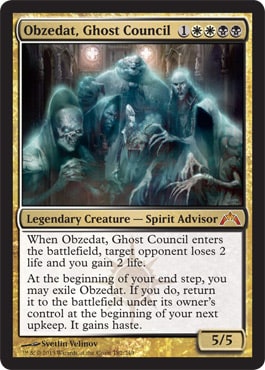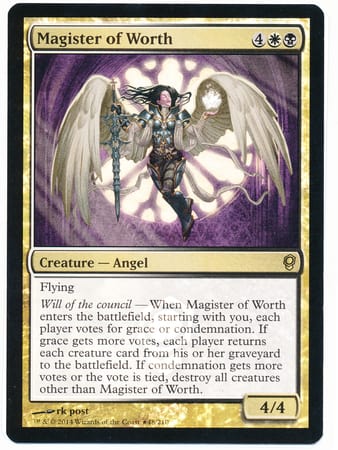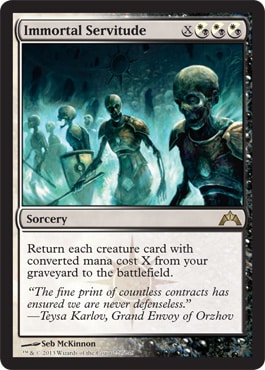Welcome back to the third deck in Abe Sargent’s and my series on how to teach Magic: the Gathering through Commander and on a budget. Next week Abe will offer the last deck, at which point we’ll have the set and be ready to start getting new players involved in a game! This article assumes you’ve read the first and the second in the series, so make sure you go back and check those out before plowing ahead!
As I was constructing this week’s deck, I hit a point where I realized my mind was trying to make the deck strong. In our effort to build decks that will appeal to a brand new player, we’re trying to balance a bunch of things here — we want to keep the cost way down, we’re limited to sorceries and creatures only, and we want to keep the effects on the simpler side. Still, my Magic brain wouldn’t shut off; I kept trying to figure out how to get more value.
Then I remembered — we’re not making traditionally “good” decks here. The plan is to make a deck which works. It needs to have a chance of beating the other three decks in the series, but more than that, it needs to create a swingy, fun experience for the pilot. It also wants to be different than the other three decks. This means we can use cards we wouldn’t even play in a draft deck but which work with our deck design. It plays nicely in the deck, costs next to nothing, and gives a clear trajectory for our new player’s mind. He’ll see the junk card but doesn’t know there is better. Then, when he sees a better card, he’ll have the worse one for comparison and will figure it out on his own, rather than just being told.
I’ve actually built an Obzedat, Ghost Council deck before, but this one is going to be quite different. We’re going to play with life gain and a few flicker effects, which is neat because it puts a more strategic deck into the series. For someone unfamiliar with gaming in general, a deck which effectively plays itself is a great place to start. For someone who plays a lot of games and just doesn’t know Magic, a deck with a little bit more thought required will be a nice addition.
Obzedat, Ghost Council ? Commander | Mark Wischkaemper
- Commander (1)
- 1 Obzedat, Ghost Council
- Creatures (45)
- 1 Angel of Mercy
- 1 Arashin Cleric
- 1 Aven Battle Priest
- 1 Blind Hunter
- 1 Cathedral Sanctifier
- 1 Cliffhaven Vampire
- 1 Courier Griffin
- 1 Deathbringer Regent
- 1 Disciple of Bolas
- 1 Felidar Guardian
- 1 Felidar Sovereign
- 1 Filigree Familiar
- 1 Fleshbag Marauder
- 1 Flickerwisp
- 1 Galepowder Mage
- 1 Glimmerpoint Stag
- 1 Goldnight Redeemer
- 1 High Priest of Penance
- 1 Kemba's Skyguard
- 1 Kingpin's Pet
- 1 Lone Missionary
- 1 Magister of Worth
- 1 Mourning Thrull
- 1 Nightsky Mimic
- 1 Nip Gwyllion
- 1 Orzhov Guildmage
- 1 Peace Strider
- 1 Planar Guide
- 1 Pontiff of Blight
- 1 Pride Guardian
- 1 Putrid Warrior
- 1 Sin Collector
- 1 Souls of the Faultless
- 1 Staunch Defenders
- 1 Syndic of Tithes
- 1 Temple Acolyte
- 1 Teroh's Faithful
- 1 Tidehollow Sculler
- 1 Tireless Missionaries
- 1 Tithe Drinker
- 1 Treasury Thrull
- 1 Vampire Nighthawk
- 1 Vectis Dominator
- 1 Venerable Monk
- 1 Vizkopa Guildmage
- Sorceries (14)
- 1 Ancient Craving
- 1 Assassinate
- 1 Blood Tithe
- 1 Death Grasp
- 1 Debt to the Deathless
- 1 Immortal Servitude
- 1 Killing Wave
- 1 Night's Whisper
- 1 Profane Command
- 1 Read the Bones
- 1 Sign in Blood
- 1 Sudden Disappearance
- 1 Syphon Mind
- 1 Syphon Soul
- Lands (40)
- 16 Plains
- 16 Swamp
- 1 Evolving Wilds
- 1 Forsaken Sanctuary
- 1 Orzhov Guildgate
- 1 Orzhova, the Church of Deals
- 1 Radiant Fountain
- 1 Scoured Barrens
- 1 Tainted Field
- 1 Terramorphic Expanse
Beginners love life gain, and we’re mostly trying to gain life here. It’s not a control deck (control is difficult without instants and lots of more complicated interactions), but something of an “I’ll get a life total so high you can’t possibly beat me, and then I’ll kill you with something of mine” deck. Most of it will be pretty straightforward, but there are a few cards worth noting because they may require some special explanation.
Blind Hunter’s “Haunt” is a bit strange and newer players may need some help with it. Cliffhaven Vampire needs to be watched because it triggers with each life gain, and that happens a lot. High Priest of Penance is a great card but can be tricky to understand. Magister of Worth will probably need a read or two before it makes sense, and Extort is on a few of the cards, which can get confusing. (Pontiff of Blight makes things even more confusing, so be ready to talk about it.) Nightsky Mimic is great but a bit tricky, and Disciple of Bolas may need a bit of work to figure out too. Deathbringer Regent and Killing Wave introduce the concept of the Wrath effect. Finally, Immortal Servitude can be weird and have a strange effect, so watch that one.
Again, though, let’s make sure we remember how to go about this. The goal is to let the new player guide the discussion. A quick discussion of how to start — draw seven cards, draw every turn at the beginning, play lands and spells and cast creatures including casting costs and how to tap for mana, a little bit on combat — then start playing. Play the first couple of games with hands visible to everyone, and let the new player make her own decisions. Don’t second guess, don’t push your own thoughts of what you think is the “correct” line of play, and don’t offer more information than absolutely necessary. We know that life gain without control and the ability to punish opponents for our gain is a weak EDH strategy, but let the pilot figure that out.
As I said in the first article, one of the keys here is to adjust the way you are teaching to the new player’s learning style. People learn in a combination of three ways, but most people use one primarily. The three styles are visual, auditory, and kinesthetic. If you already know a fair amount about these, maybe skip the next three paragraphs, but it’s probably worth spending a little time on this.
Visual learners learn by seeing. The most common way is reading it. This is why teachers write on boards at the front of class, but for Magic players, it means she needs to read the card.
Auditory learners learn by hearing. Most often, someone says the thing. This is why teachers lecture or talk about the subject, and for Magic players, he needs someone to tell him what the card does.
Kinesthetic learners learn by doing. This is why teachers have students take notes and do projects, though for Magic players, she’ll need to just play the card and see what happens.
The challenge for the teacher is realizing he may learn in a different way than the student, and not to force that teaching style. If we’re, for example, auditory, we’ll be inclined to want to tell our new player how her cards work. But if she’s visual, we won’t be helping her, since she needs to read the cards to get it.
On the other hand, most often new players will give us plenty of cues about how they learn. If she needs to hear it, she’ll ask for clarification. If he is visual, he’ll read the cards and only ask if something isn’t explained (if a card, for example, says “Vigilance” but doesn’t have the reminder text, he might need to ask). And if she just starts playing cards without asking or reading carefully, then she’s kinesthetic and that’s how she learns. The trick is to watch those cues and respond, rather than offer before it’s been asked.
This deck clocks in at $24.40, so we’ve still got plenty of our budget left for the final deck and the optionboards. Additionally, lots of the cards are changeable. It’s pretty hard to do more flickering in a ![]()
![]() deck, but there are other lifegain cards out there if you think your new player can handle them. And if an instant (or some other card type) slips its way in there, don’t worry about it, just bypass it for the moment. For the first few games, instants are just sorceries (we’ll cover the differences later). Artifacts are just like creatures that do things all the time or have abilities.
deck, but there are other lifegain cards out there if you think your new player can handle them. And if an instant (or some other card type) slips its way in there, don’t worry about it, just bypass it for the moment. For the first few games, instants are just sorceries (we’ll cover the differences later). Artifacts are just like creatures that do things all the time or have abilities.
Once again, this deck is for someone who thinks strategically and likes a bit of a challenge. If she is a regular at your LGS for their X-Wing night, spent some time with AD&D in high school, and has a big collection of indie board games, this kind of deck would probably be a good fit. (You’re also probably going to want to start adding new card types in quite quickly.) On the other hand, if the new player is your roommate who’s never been to a game store and hasn’t played anything more complicated than Monopoly, something a bit more straightforward, like Abe’s Zombie Chomp, is probably a better choice. The key is to do your best to pick the deck right for the player. Trust your instincts.
Check back next week for Abe’s last deck in the series. If it’s anything like his normal deck construction, it’ll be awesome! What stories do you have of teaching people to play Commander? What worked? What didn’t? Let us know! ‘Til next week.

























